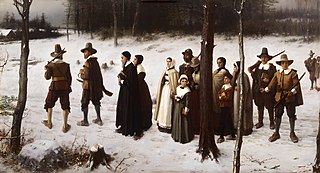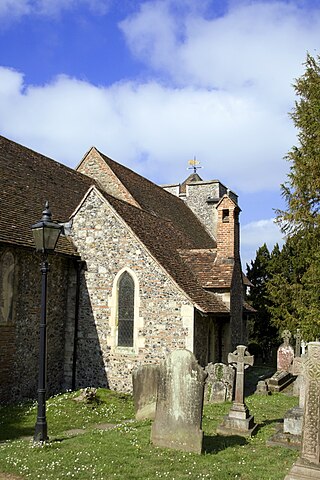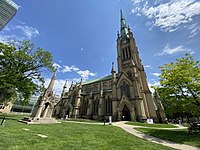A Christian denomination is a distinct religious body within Christianity that comprises all church congregations of the same kind, identifiable by traits such as a name, particular history, organization, leadership, theological doctrine, worship style and, sometimes, a founder. It is a secular and neutral term, generally used to denote any established Christian church. Unlike a cult or sect, a denomination is usually seen as part of the Christian religious mainstream. Most Christian denominations refer to themselves as churches, whereas some newer ones tend to interchangeably use the terms churches, assemblies, fellowships, etc. Divisions between one group and another are defined by authority and doctrine; issues such as the nature of Jesus, the authority of apostolic succession, biblical hermeneutics, theology, ecclesiology, eschatology, and papal primacy may separate one denomination from another. Groups of denominations—often sharing broadly similar beliefs, practices, and historical ties—are sometimes known as "branches of Christianity". These branches differ in many ways, especially through differences in practices and belief.
Religion in Canada encompasses a wide range of beliefs and customs. The constitution of Canada refers to God and the monarch carries the title of Defender of the Faith, however Canada has no official church and the government is officially committed to religious pluralism. Freedom of religion in Canada is a constitutionally protected right, allowing individuals to assemble and worship without limitation or interference.

The mainline Protestant churches are a group of Protestant denominations in the United States and in some cases Protestant denominations in Canada largely of the theologically liberal or theologically progressive persuasion that contrast in history and practice with the largely theologically conservative Evangelical, Fundamentalist, Charismatic, Confessional, Confessing Movement, historically Black church, and Global South Protestant denominations and congregations. Some make a distinction between "mainline" and "oldline", with the former referring only to denominational ties and the latter referring to church lineage, prestige and influence. However, this distinction has largely been lost to history and the terms are now nearly synonymous.

Christianity is the largest religion in Belgium, with the Catholic Church representing the largest community, though it has experienced a significant decline since the 1950s. Belgium's policy separates the state from the churches, and freedom of religion of the citizens is guaranteed by the country's constitution.

There are between 800 million and 1 billion Protestants worldwide, among approximately 2.5 billion Christians. In 2010, a total of more than 800 million included 300 million in Sub-Saharan Africa, 260 million in the Americas, 140 million in Asia-Pacific region, 100 million in Europe and 2 million in Middle East-North Africa. Protestants account for nearly forty percent of Christians worldwide and more than one tenth of the total human population. Various estimates put the percentage of Protestants in relation to the total number of the world's Christians at 33%, 36%, 36.7%, and 40%, while in relation to the world's population at 11.6% and 13%.

The history of religion in the Netherlands has been characterized by considerable diversity of religious thought and practice. From 1600 until the second half of the 20th century, the North and West had embraced the Protestant Reformation and were Calvinist. The southeast was predominately Catholic. Associated with immigration from Arab world of the 20th century, Muslims and other minority religions were concentrated in ethnic neighborhoods in the cities.
Protestantism originated from the Protestant Reformation of the 16th century. The term Protestant comes from the Protestation at Speyer in 1529, where the nobility protested against enforcement of the Edict of Worms which subjected advocates of Lutheranism to forfeit of all their property. However, the theological underpinnings go back much further, as Protestant theologians of the time cited both Church Fathers and the Apostles to justify their choices and formulations. The earliest origin of Protestantism is controversial; with some Protestants today claiming origin back to people in the early church deemed heretical such as Jovinian and Vigilantius.

Religion has been a major influence on the societies, cultures, traditions, philosophies, artistic expressions and laws within present-day Europe. The largest religion in Europe is Christianity. However, irreligion and practical secularisation are also prominent in some countries. In Southeastern Europe, three countries have Muslim majorities, with Christianity being the second-largest religion in those countries. Ancient European religions included veneration for deities such as Zeus. Modern revival movements of these religions include Heathenism, Rodnovery, Romuva, Druidry, Wicca, and others. Smaller religions include Indian religions, Judaism, and some East Asian religions, which are found in their largest groups in Britain, France, and Kalmykia.

Christianity is the largest religion in Seychelles, with Roman Catholicism being its largest denomination.

The Catholic branch of Christianity is the dominant religion in Mexico, representing 78% of the total population as of 2020. In recent decades the share of Catholics has been declining, due to the growth of other Christian denominations – especially various Protestant churches, Jehovah's Witness and Mormonism – which now constitute larger shares of the population. Conversion to non-Catholic denominations has been considerably lower than in Central America, and central Mexico remains one of the most Catholic areas in the world.

Religion in Austria is predominantly Christianity, adhered to by 68.2% of the country's population according to the 2021 national survey conducted by Statistics Austria. Among Christians, 80.9% were Catholics, 7.2% were Orthodox Christians, 5.6% were Protestants, while the remaining 6.2% were other Christians, belonging to other denominations of the religion or not affiliated to any denomination. In the same census, 8.3% of the Austrians declared that their religion was Islam, 1.2% declared to believe in other non-Christian religions, and 22.4% declared they did not belong to any religion, denomination or religious community.

Christianity is the most prevalent religion in the United States. Estimates from 2021 suggest that of the entire U.S. population about 63% is Christian. The majority of Christian Americans are Protestant Christians, though there are also significant numbers of American Roman Catholics and other Christian denominations such as Latter-day Saints, Orthodox Christians and Oriental Orthodox Christians, and Jehovah's Witnesses. The United States has the largest Christian population in the world and, more specifically, the largest Protestant population in the world, with nearly 210 million Christians and, as of 2021, over 140 million people affiliated with Protestant churches, although other countries have higher percentages of Christians among their populations. The Public Religion Research Institute's "2020 Census of American Religion", carried out between 2014 and 2020, showed that 70% of Americans identified as Christian during this seven-year interval. In a 2020 survey by the Pew Research Center, 65% of adults in the United States identified themselves as Christians. They were 75% in 2015, 70.6% in 2014, 78% in 2012, 81.6% in 2001, and 85% in 1990. About 62% of those polled claim to be members of a church congregation.
Protestantism is the largest religious demographic in the United Kingdom.

Religion in Guyana is diverse, with Christianity being the most widely professed faith.

Christianity is the most adhered to religion in Canada, with 19,373,330 Canadians, or 53.3%, identifying themselves as of the 2021 census. The preamble to the Canadian Charter of Rights and Freedoms refers to God. The French colonization beginning in the 17th century established a Roman Catholic francophone population in New France, especially Acadia and Lower Canada. British colonization brought waves of Anglicans and other Protestants to Upper Canada, now Ontario. The Russian Empire spread Orthodox Christianity in a small extent to the tribes in the far north and western coasts, particularly hyperborean nomads like the Inuit. Orthodoxy would arrive in mainland Canada with immigrants from the eastern and southern Austro-Hungarian Empire and western Russian Empire starting in the 1890s; then refugees from the Soviet Union, Eastern Bloc, Greece and elsewhere during the last half of the 20th century.

Christianity was introduced to North America as it was colonized by Europeans beginning in the 16th and 17th centuries. The Spanish, French, and British brought Roman Catholicism to the colonies of New Spain, New France and Maryland respectively, while Northern European peoples introduced Protestantism to Massachusetts Bay Colony, New Netherland, Virginia colony, Carolina Colony, Newfoundland and Labrador, and Lower Canada. Among Protestants, adherents to Anglicanism, Methodism, the Baptist Church, Congregationalism, Presbyterianism, Lutheranism, Quakerism, Mennonite and the Moravian Church were the first to settle in the US, spreading their faith in the new country.

Protestantism is a branch of Christianity that follows the theological tenets of the Protestant Reformation, a movement that began in the 16th century with the goal of reforming the Catholic Church from perceived errors, abuses, and discrepancies.

Christianity was introduced with the first European settlers beginning in the 16th and 17th centuries. Colonists from Northern Europe introduced Protestantism in its Anglican and Reformed forms to Plymouth Colony, Massachusetts Bay Colony, New Netherland, Virginia Colony, and Carolina Colony. The first arrivals were adherents to Anglicanism, Congregationalism, Presbyterianism, Methodism, the Baptist Church, Calvinism, Lutheranism, Quakerism, Anabaptism and the Moravian Church from British, German, Dutch, and Nordic stock. America began as a significant Protestant majority nation. Significant minorities of Roman Catholics and Jews did not arise until the period between 1880 and 1910.

The history of Christianity in Britain covers the religious organisations, policies, theology and popular religiosity since ancient times.
The decline of Christianity in the Western world is the decreasing Christian affiliation in the Western world. While most countries in the Western world were historically almost exclusively Christian, the post-World War II era has seen developed countries with modern, secular educational facilities shifting towards post-Christian, secular, globalized, multicultural and multifaith societies. While Christianity is currently the predominant religion in Latin America, Europe, Canada and the United States, the religion is declining in many of these areas, including Western Europe, North America, and Oceania. A decline in Christianity among countries in Latin America's Southern Cone has also contributed to a rise in irreligion in Latin America.














